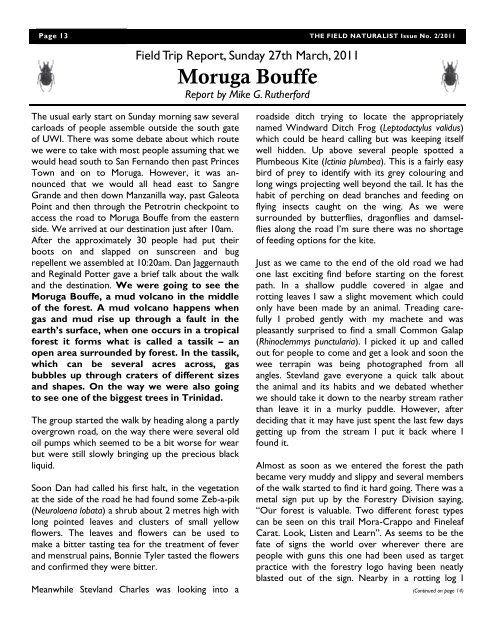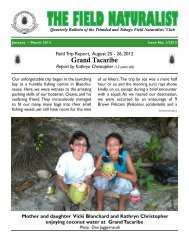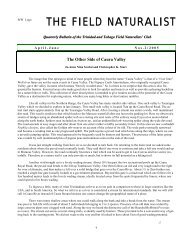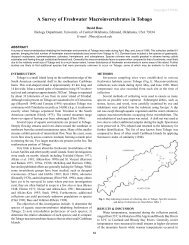Moruga Bouffe - The Trinidad and Tobago Field Naturalists' Club
Moruga Bouffe - The Trinidad and Tobago Field Naturalists' Club
Moruga Bouffe - The Trinidad and Tobago Field Naturalists' Club
Create successful ePaper yourself
Turn your PDF publications into a flip-book with our unique Google optimized e-Paper software.
Page 13 THE FIELD NATURALIST Issue No. 2/2011<strong>Field</strong> Trip Report, Sunday 27th March, 2011<strong>Moruga</strong> <strong>Bouffe</strong>Report by Mike G. Rutherford<strong>The</strong> usual early start on Sunday morning saw severalcarloads of people assemble outside the south gateof UWI. <strong>The</strong>re was some debate about which routewe were to take with most people assuming that wewould head south to San Fern<strong>and</strong>o then past PrincesTown <strong>and</strong> on to <strong>Moruga</strong>. However, it was announcedthat we would all head east to SangreGr<strong>and</strong>e <strong>and</strong> then down Manzanilla way, past GaleotaPoint <strong>and</strong> then through the Petrotrin checkpoint toaccess the road to <strong>Moruga</strong> <strong>Bouffe</strong> from the easternside. We arrived at our destination just after 10am.After the approximately 30 people had put theirboots on <strong>and</strong> slapped on sunscreen <strong>and</strong> bugrepellent we assembled at 10:20am. Dan Jaggernauth<strong>and</strong> Reginald Potter gave a brief talk about the walk<strong>and</strong> the destination. We were going to see the<strong>Moruga</strong> <strong>Bouffe</strong>, a mud volcano in the middleof the forest. A mud volcano happens whengas <strong>and</strong> mud rise up through a fault in theearth’s surface, when one occurs in a tropicalforest it forms what is called a tassik – anopen area surrounded by forest. In the tassik,which can be several acres across, gasbubbles up through craters of different sizes<strong>and</strong> shapes. On the way we were also goingto see one of the biggest trees in <strong>Trinidad</strong>.<strong>The</strong> group started the walk by heading along a partlyovergrown road, on the way there were several oldoil pumps which seemed to be a bit worse for wearbut were still slowly bringing up the precious blackliquid.Soon Dan had called his first halt, in the vegetationat the side of the road he had found some Zeb-a-pik(Neurolaena lobata) a shrub about 2 metres high withlong pointed leaves <strong>and</strong> clusters of small yellowflowers. <strong>The</strong> leaves <strong>and</strong> flowers can be used tomake a bitter tasting tea for the treatment of fever<strong>and</strong> menstrual pains, Bonnie Tyler tasted the flowers<strong>and</strong> confirmed they were bitter.Meanwhile Stevl<strong>and</strong> Charles was looking into aroadside ditch trying to locate the appropriatelynamed Windward Ditch Frog (Leptodactylus validus)which could be heard calling but was keeping itselfwell hidden. Up above several people spotted aPlumbeous Kite (Ictinia plumbea). This is a fairly easybird of prey to identify with its grey colouring <strong>and</strong>long wings projecting well beyond the tail. It has thehabit of perching on dead branches <strong>and</strong> feeding onflying insects caught on the wing. As we weresurrounded by butterflies, dragonflies <strong>and</strong> damselfliesalong the road I’m sure there was no shortageof feeding options for the kite.Just as we came to the end of the old road we hadone last exciting find before starting on the forestpath. In a shallow puddle covered in algae <strong>and</strong>rotting leaves I saw a slight movement which couldonly have been made by an animal. Treading carefullyI probed gently with my machete <strong>and</strong> waspleasantly surprised to find a small Common Galap(Rhinoclemmys punctularia). I picked it up <strong>and</strong> calledout for people to come <strong>and</strong> get a look <strong>and</strong> soon thewee terrapin was being photographed from allangles. Stevl<strong>and</strong> gave everyone a quick talk aboutthe animal <strong>and</strong> its habits <strong>and</strong> we debated whetherwe should take it down to the nearby stream ratherthan leave it in a murky puddle. However, afterdeciding that it may have just spent the last few daysgetting up from the stream I put it back where Ifound it.Almost as soon as we entered the forest the pathbecame very muddy <strong>and</strong> slippy <strong>and</strong> several membersof the walk started to find it hard going. <strong>The</strong>re was ametal sign put up by the Forestry Division saying,―Our forest is valuable. Two different forest typescan be seen on this trail Mora-Crappo <strong>and</strong> FineleafCarat. Look, Listen <strong>and</strong> Learn‖. As seems to be thefate of signs the world over wherever there arepeople with guns this one had been used as targetpractice with the forestry logo having been neatlyblasted out of the sign. Nearby in a rotting log I(Continued on page 14)








